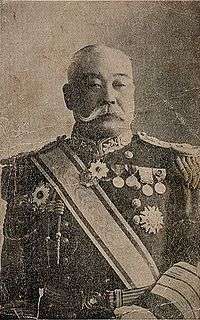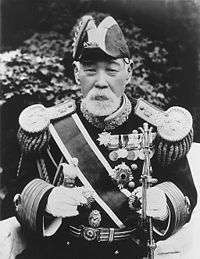Inoue Yoshika
| Viscount Inoue Yoshika | |
|---|---|
|
Japanese Admiral Viscount Inoue Yoshika | |
| Native name | 井上 良馨 |
| Born |
3 November 1845 Kagoshima, Satsuma domain, Japan |
| Died |
22 March 1929 (aged 83)[1] Tokyo, Japan |
| Allegiance | Empire of Japan |
| Service/branch | Imperial Japanese Navy |
| Years of service | 1868-1911 |
| Rank | Marshal Admiral |
| Commands held |
|
| Battles/wars | |
| Awards |
Order of the Sacred Treasure Order of the Rising Sun Order of the Chrysanthemum |
Marshal Admiral Viscount Inoue Yoshika (井上 良馨, 3 November 1845 – 22 March 1929) was a career naval officer and admiral in the Imperial Japanese Navy during Meiji-period Japan.
Biography
Born in what is now part of Kagoshima city, as the son of a samurai retainer of the Satsuma Domain, Inoue took part in the Anglo-Satsuma War as a youth. Although severely injured by shrapnel through his left thigh during the fighting, he was extremely impressed with the firepower of the Royal Navy and the amount of material damage that only a few vessels were able to inflict on Kagoshima. On recovery, he enlisted in the Satsuma Navy, and present at all of the major naval engagements associated with the Boshin War to overthrow the Tokugawa Shogunate, as commander of the Satsuma warship Kasuga.[2]
After the Meiji Restoration and the absorption of the various feudal navies into central government control, Inoue reenlisted as a lieutenant in the fledgling Imperial Japanese Navy, serving on the Ryūjō, rising to the position of executive officer by 1872, and returning to the Kasuga again as its captain in 1874.
Inoue was a supporter of Saigō Takamori and his Seikanron position vis-a-vis Korea. At the time of the Ganghwa Island incident (1875), Inoue was captain of the gunboat Un'yo and played a key role in the events which led to the opening of Korea to foreign trade and diplomatic relations. Inoue then was assigned to the new corvette Seiki of which he was the chief equipping officer in charge of overseeing her construction. Seiki was the first domestically-produced Japanese warship.
Despite his admiration for Saigō and some concerns that he might defect with the Seiki, Inoue remained loyal to the Meiji government against his former Satsuma clansmen during the Satsuma Rebellion. In October 1877, Inoue was assigned to take Seiki on a voyage to Europe and back. Seiki passed through the Suez Canal, and made a port call at Constantinople, where Inoue was received in an audience by the Ottoman Sultan, and eventually reached London. The voyage was hailed in the foreign press as a major achievement for Japan.
On his return to Japan, Inoue captained a wide selection of ships in the Japanese navy, including the Azuma, Asama, Fusō and Kongō. Inoue was promoted to commander in June 1882 and to rear admiral on 15 June 1886, and appointed Director of the Bureau of Naval Affairs shortly thereafter. He was ennobled with the title of danshaku (baron) under the kazoku peerage system on 24 May 1887.
Inoue became first commandant of the Imperial Japanese Naval Academy on 16 August 1888. He became Commander-in-Chief of the Readiness Fleet on 29 July 1889, and vice admiral and commander-in-chief of the Sasebo Naval District on 12 December 1892. He remained in charge of reserve forces, and thus did not see any combat during the First Sino-Japanese War of 1895. He was commander-in-chief of the Kure Naval District from 26 February 1896 to 20 May 1900. In November 1900, he was awarded the Order of the Sacred Treasure, 1st class. Inoue was commander-in-chief of the Yokosuka Naval District from 20 May 1901 to 14 January 1905. He was promoted to admiral on 12 December 1901. In November 1905, he was awarded the Grand Cordon of the Order of the Rising Sun.

After the Russo-Japanese War, Inoue was elevated to shishaku (viscount) on 21 September 1907, and to the largely ceremonial rank of Fleet Admiral on his retirement on 31 October 1911. After retirement, Inoue continued to exert an influence on naval policy, and was a strong proponent of the occupation and annexation of the Caroline Islands during World War I [3]
Inoue died in 1929. His grave is in his hometown of Kagoshima.
References
- Hoare, J.E. (1999). Britain and Japan: Biographical Portraits, Vol.III. California, USA: RoutledgeCurzon. ISBN 1-873410-89-1.
- Schencking, J. Charles (2005). Making Waves: Politics, Propaganda, And The Emergence Of The Imperial Japanese Navy, 1868-1922. California, USA: Stanford University Press. ISBN 0-8047-4977-9.
External links
| Wikimedia Commons has media related to Inoue Yoshika. |
- Nishida, Hiroshi. "Materials of IJN: Inoue, Yoshika". Imperial Japanese Navy. Retrieved 2007-08-03.
